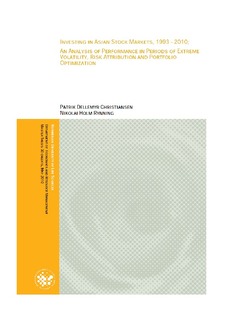| dc.description.abstract | The Asian stock markets are emerging, which make them interesting to foreign investors who may see a potential future in these markets. We assume the position of an investor reporting results in US Dollars and analyze the results from investing in ten Asian stock markets (represented by their MSCI country indices). We are particularly analyzing the ten selected Asian stock markets during periods of extreme volatility and during the period 1993 - 2010. The periods of market turmoil are the Asian Financial Crisis (1997 – 1998), the Dot-Com Bubble Crash and September 11 (2000 – 2002) and the Great Financial Crisis (2007 – 2009). Emerging markets have proved to yield higher returns and have higher risk than developed countries in the past. With higher volatility connected to country-specific risk, the inclusion of emerging markets in a portfolio may still have a positive effect on the investment.
The first part of the analysis makes a comparison of developed and Asian countries concerning return and risk, emphasizing betas, Sharpe ratios and correlations, during each selected period of extreme volatility. From 1993 – 2010 the general picture of the Asian countries is that there is a large amount of country-specific risk, using a world index as a benchmark. The Asian markets generally have higher risk and lower average returns than the developed countries from 1993 – 2010 and eight out of ten Asian countries have betas above the market beta. There are only three Asian countries that have marginally performed better than the risk free rate during this period, in all other selected periods the Asian countries have underperformed compared to the risk free rate concerning Sharpe ratios.
During the Dot-Com Bubble Crash and the September 11 effect, most of the Asian countries have higher risk than the developed countries, but the negative returns are approximately equal to the average among the developed countries. As during the Asian Financial Crisis, the Asian countries have higher amounts of country-specific risk than the developed countries on average.
Most of the Asian countries have higher risk than the developed countries, but the negative returns are somewhat lower among the Asian countries compared to the developed countries. Yet, the Great Financial Crisis has made the Asian countries more equal to the developed countries concerning return and risk. What is worth noticing is that the amount of systematic risk has increased dramatically among the Asian countries and is approaching the systematic risk level of the developed countries. The GFC led to all countries underperforming compared to the risk free rate, as well. The average Sharpe ratio improves for the Asian countries during the GFC, compared to the developed countries.
During periods of extreme volatility, the currencies of smaller markets tend to depreciate relative to the currencies of larger markets. During these periods, investors seem to invest in large markets with more stable currencies, which contributes to further depreciation of the smaller markets’ currencies. For a USD-investor there is significant currency risk by investing internationally, especially in smaller markets, or markets that are considered emerging.
The Great Financial Crisis, the most recent period of high volatility, is the period with highest correlation between Asia and the developed countries. This may suggest that Asia is becoming more equal to the developed world, in other words, the Asian stock markets are becoming more integrated with the developed markets.
There is a connection between a country’s risk and the risk of the dominating sector in that country. This might mean that high risk in an Asian country is not exclusively due to country-specific factors, but is affected by a worldwide downfall in a specific sector’s return. This combination of events contributes to high standard deviations in the Asian countries. Our findings suggest that the systematic risk in several Asian countries has been affected by periods of extreme volatility, within different sectors. The regression model applied in this section shows that there are significant differences in the systematic risk of a country during the period from 1994 – 2010 and during the selected periods of market turmoil, within different sectors.
We finally constructed three optimal portfolios (defined as the minimum variance portfolios) from 2003 – 2010. We found that in an optimal portfolio based on data from 1993 – 2003, with restrictions on short-sales, and a moderate required return, only one Asian country is being included in the portfolio. This country was India, with a portfolio weight of about 0.09. | en_US |
